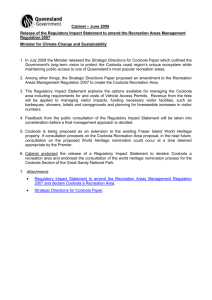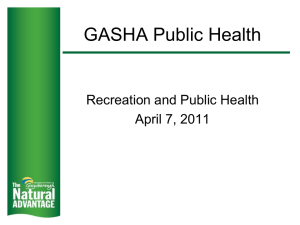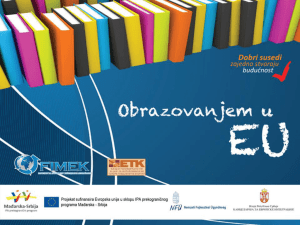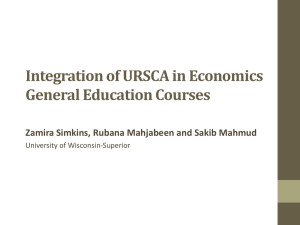Il programma
advertisement
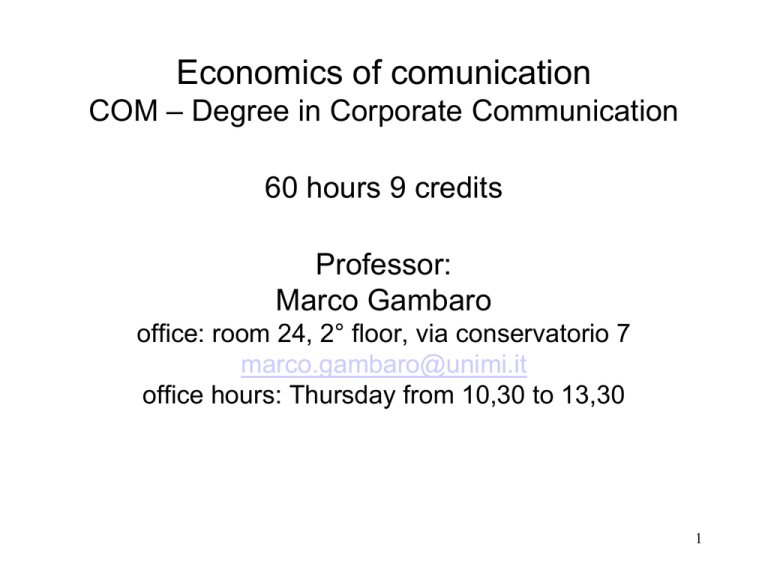
Economics of comunication COM – Degree in Corporate Communication 60 hours 9 credits Professor: Marco Gambaro office: room 24, 2° floor, via conservatorio 7 marco.gambaro@unimi.it office hours: Thursday from 10,30 to 13,30 1 abstract • This course is a survey of economic issues in communication and cultural industries. • It examines some of the special aspects of these businesses that complicate the market processes, such as the particular nature of demand for experience goods, pricing strategy, scale economies and obstacles to market equilibrium that motivate public policy • The goal is to give economic instruments for the analysis of the areas of communication and their specific problems with regard to competition, business strategies and public policies 2 Course objectives • We will survey several industries to provide an overview of the markets for different kinds of information goods. • We will use the tools of microeconomics and of industrial economics to provide insights about features and processes that explain the specific outcomes observed in the markets for experience goods, cultural goods and information goods. 3 Why economics of communication and culture ? • There Are Unique Aspects of the Market – – – – – – • Creative talent in production – the creator has a personal interest in the product. Pricing decisions – many opportunities for strategic pricing. Zero marginal cost, production vs. replication/distribution. Relationship between buyer and seller – artists and fans. Market complementarities shape market structures – winner take all markets. Demand aspects are unlike conventional commodity markets. There Are Some Commonalities that Allow Conventional Economic Analyses – Production concepts – the nature of production and supply, technological change. – Market dynamics – market structure, market power, market outcomes. – Demand concepts – elasticity, consumer surplus, pricing. 4 Industries examinated will include: • Movie business: the project nature of production, vertical integration, specific contingent contract • Music and publishing with emphasis on intellectual property • Television and radio and the fundamental differences between public and private broadcasting market • Art market • Live performances • Museum and cultural heritage • Book publishing 5 Some contents Production and costs (fixed and variable) Demand and elasticity Perfect competition and monopoly Oligopoly Vertical integration Market definition and concentration Windowing and price discrimination Definition of media markets Two sided market Barriers to entry Collusion and price war Differentiation Pricing Advertising and competition Public policy and antitrust 6 Some contents • • • • • • • • • Costs desease Team production Subsidies in cultural sector Merit goods Principal agent model Copyright and piracy Transaction cost theory of the firm Product novelty and perceived risk, nobody knows Search and information costs: gate keepers and critics, network effects, banwagon and snowball 7 textbooks • Ruth Towse, A textbook of cultural economics, Cambridge University Press • Lipczynski, Wilson, Goddard, Industrial organization: competition, strategy, policy, Prentice Hall • Evan, Schmalensee, The industrial organization of market with two sided platform , downlodable papers (ariel) • Teaching notes downlodable (ariel) 8 Course agenda Week 1-6 lectures (with some cases, policy discussions and guest lectures) Week 7: midterm exam Week 7-10 assisted group projectwork (market study, industry analysis) Week 10 Presentations 9 Course requirements If you attend lectures, course grade will be based on: • Mid-term written exam (7-8 short answer) 50% • Written assignement 25% • Presentation 15% • Cases and class exercise 10% If you will not attend the lectures, grade will be based on a written exam with a slightly larger text list 10 Prerequisites • Some basic economic ideas about supply and demand; competition and monopoly • Some knowledge of media organizations and markets. Information products • Some familiarity with graphs and curve representations 11 In order to remember Some chapters of any basic book of economics Lieberman-Hall, Economics: principles and applications Slomann, Garrett, Essentials of economics Frank, Microeconomics and behaviours For media, culture and communication Opening chapters of Towse’s book Gillian Doyle, Understanding media economics, Sage Alan Albarran, Media Economics: Understanding Markets, Industries and Concepts 12 Some starting points • If firms have market power they can increase prices • How do they build market power and how do they conserve it? • Which are the consequences for different agents and for the society as a whole? • What can public policies and industrial policies make about that? 13 Long Run Trend: Hours Worked US 1850-1956 Hours worked stops falling; hours spent on recreation (not working) stops rising. 14 Economic fluctuations have much greater impact on manufacturing than on services. Recent trend in hours worked (weekly, average), 1965-2009 15 Spending on recreation is growing in absolute terms Per capita, real spending on recreation and recreation services. 16 The long run trend in recreation expenditure as a proportion of real income is growing Recreation as a % of Disposable Income 17 The form of recreation spending is changing Service Component of Recreation Expenditures Service = Movies, Sports, … (passive) 1959-2009 18 Adding It Up • • • • Household income is not rising very much Time spent working is steady or falling slightly Time spent on recreation is no longer rising Budget allocated to: – entertainment, health care are rising – food and clothing are falling • Growing entertainment market is driven by – budget reallocation – changes in preferences. – changing technologies and falling prices • Demand in the recreational segment of the economy is rising faster than overall output. 19 Economic features of information goods • • • • Intangible Non rival in consumption Hardly excludable Difficult define iownership • MANY FEATURES LIKE PUBLIC GOODS 20 Business models for information goods Three main strategies • Advertising • Selling the product ( subscription) • Public support Mixed stategies are emerging in digital world • Fremium • Complementary products • Flat rate (all you can eat) 21 Costs of information goods Costly to produce Cheap to distribute Usually high initial fixed cost Unitary costs of reproduduction are very low Mainly sunk sunk (price war and more risks) Costant marginal cost (small scale economies in industrial segment) Traditional equilibrium does not always work Raise the output will reduce average costs 22



